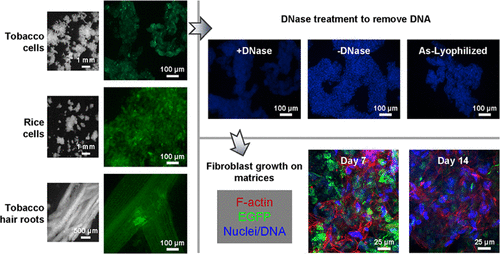当前位置:
X-MOL 学术
›
ACS Biomater. Sci. Eng.
›
论文详情
Our official English website, www.x-mol.net, welcomes your feedback! (Note: you will need to create a separate account there.)
In Vitro Biocompatibility of Decellularized Cultured Plant Cell-Derived Matrices
ACS Biomaterials Science & Engineering ( IF 5.8 ) Pub Date : 2020-01-22 , DOI: 10.1021/acsbiomaterials.9b00870 Nhi V. Phan 1 , Tristen Wright 2 , M. Masrur Rahman 1 , Jianfeng Xu 3, 4 , Jeannine M. Coburn 1
ACS Biomaterials Science & Engineering ( IF 5.8 ) Pub Date : 2020-01-22 , DOI: 10.1021/acsbiomaterials.9b00870 Nhi V. Phan 1 , Tristen Wright 2 , M. Masrur Rahman 1 , Jianfeng Xu 3, 4 , Jeannine M. Coburn 1
Affiliation

|
There has been a recent increase in exploring the use of decellularized plant tissue as a novel “green” material for biomedical applications. As part of this effort, we have developed a technique to decellularize cultured plant cells (tobacco BY-2 cells and rice cells) and tissue (tobacco hairy roots) that uses deoxyribonuclease I (DNase I)). As a proof of concept, all cultured plant cells and tissue were transformed to express recombinant enhanced green fluorescent protein (EGFP) to show that the proteins of interest could be retained within the matrices. Decellularization of lyophilized tobacco BY-2 cells with DNase for 30 min depleted the DNA content from 1503 ± 459 to 31 ± 5 ng/sample. The decellularization procedure resulted in approximately 36% total protein retention (154 ± 60 vs 424 ± 70 μg/sample) and 33% EGFP retention. Similar results for DNA removal and protein retention were observed with the rice cells and tobacco hairy root matrices. When exposed to decellularized BY-2 cell-derived matrices, monolayer cultures of human foreskin fibroblasts (hFFs) maintained or increased metabolic activity, which is an indicator of cell viability. Furthermore, hFFs were able to attach, spread, and proliferate when cultured with the decellularized BY-2 cell-derived matrices in an aggregate model. Overall, these studies demonstrate that cultured plant cells and tissue can be effectively decellularized with DNase I with substantial protein retention. The resulting material has a positive impact on hFF metabolic activity and could be employed to create a three-dimensional environment for cell growth. These results thus show the promise of using naturally derived cellulose matrices from cultured plant cells and tissues for biomedical applications.
中文翻译:

去细胞培养植物细胞衍生基质的体外生物相容性
在探索使用脱细胞的植物组织作为生物医学应用的新型“绿色”材料方面,最近有了增加。作为这项工作的一部分,我们开发了一种使用脱氧核糖核酸酶I(DNase I)对培养的植物细胞(烟草BY-2细胞和水稻细胞)和组织(烟草毛状根)进行脱细胞技术。作为概念证明,所有培养的植物细胞和组织均经过转化以表达重组增强的绿色荧光蛋白(EGFP),以表明目标蛋白可以保留在基质中。用DNase将冻干的烟草BY-2细胞脱细胞30分钟,使DNA含量从1503±459减少到31±5 ng /样品。脱细胞过程导致大约36%的总蛋白保留(154±60 vs 424±70μg/样品)和33%的EGFP保留。在水稻细胞和烟草毛状根基质上观察到了相似的DNA去除和蛋白质保留结果。当暴露于脱细胞的BY-2细胞衍生基质时,人包皮成纤维细胞(hFFs)的单层培养可维持或增加代谢活性,这是细胞活力的指标。此外,当与脱细胞的BY-2细胞来源的基质一起培养时,hFFs能够附着,扩散和增殖。总体而言,这些研究表明,培养的植物细胞和组织可以有效地用DNase I脱细胞,并保留大量蛋白质。所得材料对hFF代谢活性具有积极影响,可用于为细胞生长创造三维环境。
更新日期:2020-01-23
中文翻译:

去细胞培养植物细胞衍生基质的体外生物相容性
在探索使用脱细胞的植物组织作为生物医学应用的新型“绿色”材料方面,最近有了增加。作为这项工作的一部分,我们开发了一种使用脱氧核糖核酸酶I(DNase I)对培养的植物细胞(烟草BY-2细胞和水稻细胞)和组织(烟草毛状根)进行脱细胞技术。作为概念证明,所有培养的植物细胞和组织均经过转化以表达重组增强的绿色荧光蛋白(EGFP),以表明目标蛋白可以保留在基质中。用DNase将冻干的烟草BY-2细胞脱细胞30分钟,使DNA含量从1503±459减少到31±5 ng /样品。脱细胞过程导致大约36%的总蛋白保留(154±60 vs 424±70μg/样品)和33%的EGFP保留。在水稻细胞和烟草毛状根基质上观察到了相似的DNA去除和蛋白质保留结果。当暴露于脱细胞的BY-2细胞衍生基质时,人包皮成纤维细胞(hFFs)的单层培养可维持或增加代谢活性,这是细胞活力的指标。此外,当与脱细胞的BY-2细胞来源的基质一起培养时,hFFs能够附着,扩散和增殖。总体而言,这些研究表明,培养的植物细胞和组织可以有效地用DNase I脱细胞,并保留大量蛋白质。所得材料对hFF代谢活性具有积极影响,可用于为细胞生长创造三维环境。



























 京公网安备 11010802027423号
京公网安备 11010802027423号